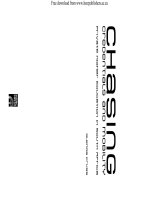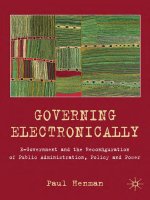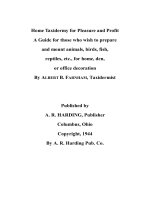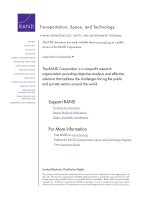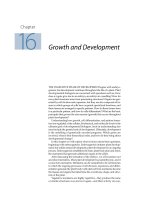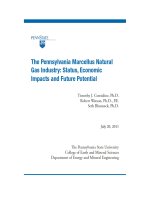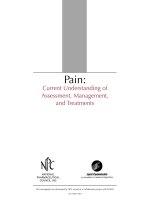SLA and motivation pot
Bạn đang xem bản rút gọn của tài liệu. Xem và tải ngay bản đầy đủ của tài liệu tại đây (804.54 KB, 44 trang )
SLA and motivation
Introduction
Types of motivation
Motivation in three stages at information
processing
How to enhance motivation in classroom
Types of demotivation
Table of contents
Definition
•
General motivation
Garder (1972), Ames (1992) & Brophy ( 2004):
Motivation: constituting a need or a desire that serves to activate
behavior; to create and sustain intentions and goal-seeking acts
•
Foreign language learning motivation
Burden (2000); Pintritch & Schunk (1996) & Karverlas ( 1996):
Motivation : referring to the need or want which energizes behavior
and gives it direction to achieve the goal.
Specifically, Williams & Burden (2002): motivation in foreign
language learning is taken more of an interest.
Types of Motivation
Types of Motivation
According to Rod Ellis (1997)
•
Instrumental motivation
•
Integrative motivation
•
Resultative motivation
•
Intrinsic motivation
Instrumental motivation
•
Functional reason
Ex:
to pass an examination
to get a better job
to get a place at university
•
Be the major force determining success in L2
learning
Integrative motivation
Learners: interested in the people and culture
represented in the target language group.
Review
1. Which of the following is an example of instrumental
motivation?
Learning Chinese to communicate with grandparents.
Learning Spanish to learn more about the culture and people of
southern Mexico.
Learning French in order to join an arts group in Montreal.
Learning Japanese to get a good work assignment in Japan.
Review
2. Whether students are successful or not in language learning depends
on whether they have specific cognitive abilities required for language
learning.
True
False
3. Motivation to learn a language is quite stable and students' motivations
rarely change.
True
False
Resultative motivation
-
Motivation is the cause of L2 achievement.
-
However, motivation that results from success in learning is referred as the
resultative motivation
•
(Ellis, 1997)
•
Ex: The people who succeed -> maintain and increase motivation
•
Ex: The people who don't succeed ->become discouraged and gain less
success
•
-> Teachers need to design interesting tasks for the learner ->
motivation as a result of learning.
Intrinsic motivation (IM)
-The arousal and maintenance of curiosity
- Learner’s particular interests
- Learners feel personally involved in learning activities
-3 types of IM (based on Self-Determination Theory
(SDT) (Deci & Ryan, 1985):
IM-Knowledge
IM-Accomplishment
IM- Stimulation
Intrinsic motivation (IM)
a. IM-Knowledge
-The pleasure of knowing new things.
Example:
+I always ask my teacher or others for English words because I
want to know many English words.
+I always volunteer to answer questions in class because I want
to see whether my answer is correct or not .
b. IM -Accomplishment
-The pleasure of accomplishing goals
Example:
+ I am proud of myself when I can say something in English.
+ I actively participate in activities to see how good I am.
L2 intrinsic motivation (IM):
L2 intrinsic motivation (IM):
c. IM-Stimulation
-The pleasure sensed when doing the task
Example:
+I like speaking English because I have a pleasant voice when I speak
English
+I have much fun in English class
Motivation in three stages of
information processing model of
foreign language learning
Content
•
Three stages of information processing
model
•
The link between motivation and three
stages of information processing
INPUT
(encountering with the new material)
CENTRAL PROCESSING
( connections between new material and existing
knowledge)
OUTPUT
( demonstration of the acquired knowledge)
Information processing model
(Duong, n.d.)
Motivation at input stage
Chomsky (see: Jane Amold,2003:13): “ the truth
of matter is that about 99% of teaching is making
the students feel interested in the material”
•
Teachers should introduce:
- Content
- Activities
- Materials related to needs of learners.
Input
(Students’ first encounter with the new material)
•
attitudes, task value, feelings of competence
Important interpretive power for learners’
variability in success or failure in FLL
classrooms
Central processing
(connections between new material and
existing knowledge)
•
the memory systems of the learners; short-
term, working and long-term memory
systems.
•
the task action control strategies
determine which actions
will be taken by learners.
Output
(demonstration of the acquired knowledge)
•
providing opportunities for contextualized,
meaningful use
•
testing out hypotheses about the target
language
•
moving the learner from a purely semantic
analysis of the language to a syntactic analysis
of it
•
proceeding to informative feedback and thus
facilitate learners’ noticing.
(Swan, 1985)
Impact of the classroom
environment on intrinsic
motivation
Competence or Autonomy?
1. I’m sure I can be a good student if I work harder, even when I do
poorly on some tasks or activities.
2. I’m certain I can understand what is taught in class if I pay attention.
3. In classroom discussion, I always feel free to say what I want to say.
4. Compared with other students in this class, I think I am a good
student.
5. I do what I do because it interests me.
6. Things I do in English class are always meaningful to me.
Perceived
competence
1. I’m sure I can be a good student if
I work harder, even when I do
poorly on some tasks or activities.
2. I’m certain I can understand what
is taught in class if I pay attention.
3. Compared with other students in
this class, I think I am a good
student.
1. In classroom discussion, I
always feel free to say what
I want to say.
2. I do what I do because it
interests me.
3. Things I do in English class
are always meaningful to
me.
Perceived
autonomy
(Wu, 2003)
